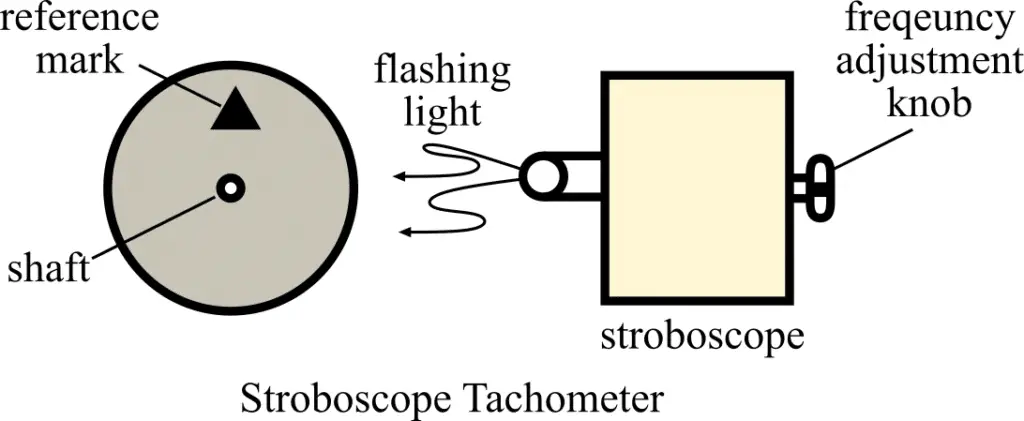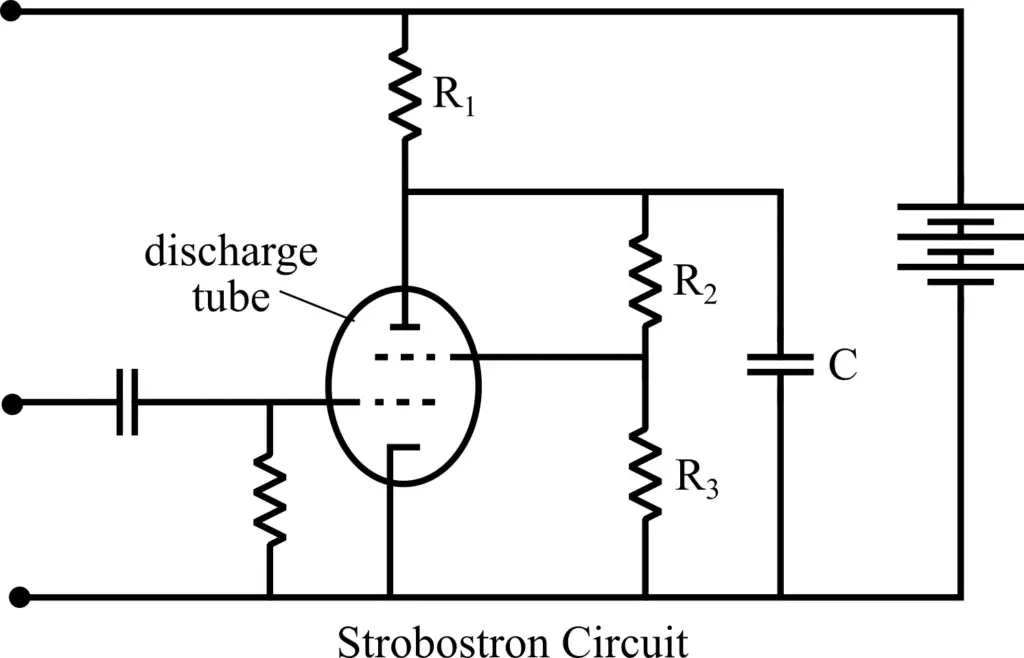In this article, we will discuss the stroboscope, stroboscope tachometer, its working principle, advantages, and disadvantages. So let us start with the basic introduction of the stroboscope instrument.
What is a Stroboscope?
An instrument that works on the principle of stroboscopic effect is referred to as a stroboscope. The stroboscope instrument creates a stop-motion effect of an object in rotation. For this, it flashes a light of high intensity on the rotating object. This stroboscopic effect and stroboscope be used to study rotating, vibrating, or oscillating objects.
In engineering, the stroboscope is mainly used to measure the rotational speed or angular velocity of a motor or any other rotating object.
The stroboscopic instrument used for measuring the rotational speed of motor shafts is called a stroboscope tachometer. The stroboscope tachometer utilizes a flashing light of variable frequency (called strobotron).
Using a stroboscope tachometer, we can measure the angular speeds of motors or other rotating machines ranging between 600 RPM to 20000 RPM.
What is a Stroboscope Tachometer?
A stroboscope tachometer is an instrument used to measure the angular velocity or rotational speed of a rotating body such as a motor. For measuring the angular speed, the stroboscope tachometer uses a flashlight. The operation of a stroboscopic tachometer is based on the stroboscopic effect.
The flashlight used in the stroboscope tachometer is of variable frequency, which means we can adjust the flashing frequency of the stroboscope light. In order to control the flashing frequency of the light, a variable frequency oscillator is utilized. We properly adjust the oscillator frequency to measure the rotational speed of the body.
The schematic arrangement for the measurement of angular speed using the stroboscopic tachometer is shown in the figure below.

From the diagram, to measure the rotational speed of the body, a reference mark is made on the rotating shaft whose angular speed is to be measured. The stroboscope tachometer consists of a neon gas discharge lamp and the settings of the tachometer are adjusted such that the light produced by it flashes directly on the reference mark made on the rotating body or shaft.
A frequency adjustment knob is used to adjust the frequency of the flashing light. The frequency of the flashlight is adjusted until the reference mark on the shaft appears to be stationary. This occurs when the frequency of the flashlight and the speed of the rotation of the shaft become equal. Therefore, the frequency of the flashing light of the stroboscope gives the rotational speed of the shaft.
What is Strobotron?
In the stroboscopic tachometer which is used for measuring the rotational speed of objects, the device which is used as the source of flashing light is referred to as strobotron.
The strobotron is basically a hot cathode gaseous discharge tube that consists of two electrodes, i.e. cathode and anode, and two grids namely, inner grid and outer grid.
The conduction happens in the discharge tube whenever the potential of the inner grid is less than or the potential of the outer grid is greater than a certain value. The discharge tube stops conducting when the anode potential becomes equal to zero.

The circuit diagram of the strobotron is shown in the figure above. It consists of a variable frequency oscillator. This oscillator is connected to the gaseous discharge tube. A variable frequency signal is produced by the strobotron which is used for flashing the light.
When the signal from the oscillator reaches the strobotron, ionization in the gaseous tube takes place and the tube starts flashing. Because of the flashing of the gaseous tube, the capacitor (C) is discharged. Therefore, a large current is drawn by the capacitor to recharge again. Due to this large current, a high voltage drop occurs across the resistor R which reduces the anode potential. This reduced potential at the anode stops the ionization process of the gas in the gaseous discharge tube and hence the production of the flashlight.
The gaseous tube starts flashing again when the next signal pulse is received from the oscillator. By changing the frequency of the signal produced by the oscillator, the frequency of flashing the light can be controlled according to requirement.
Advantages of Stroboscope Tachometer
The major advantages of the stroboscope tachometer are as follows:
- Using a stroboscope tachometer, the angular velocity or rotational speed of an object can be measured without making any physical contact with it.
- The Stroboscope tachometer does not require any special attachment with the shaft or rotating body.
- The Stroboscope tachometer does not impose any load on the shaft.
Disadvantages of Stroboscope Tachometer
The following are the major disadvantages of the stroboscope tachometer:
- The variable frequency oscillator used in the stroboscope tachometer cannot be stabilized to a fixed frequency. It affects the accuracy of the measurement.
- The stroboscope tachometer cannot be used in an environment where the ambient light is above a certain level.
Applications of Stroboscope Tachometer
The following are the common applications of the stroboscope tachometer:
- A Stroboscope tachometer is used to measure the speed of periodic or rotational motions.
- It is used to measure the speed of electric motors.
- It is also used in laboratory work.
Hence, this is all about the stroboscope and the stroboscope tachometer. In conclusion, the stroboscope tachometer is a widely used device for measuring rotational speeds or angular velocity of rotating bodies.